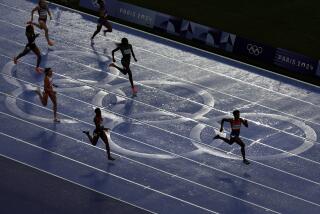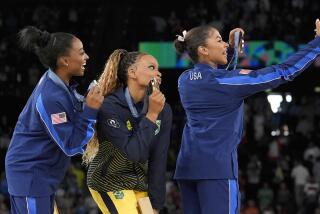A High Price for Gold? : Now that female athletes are pushing their bodies more they find peak performance can also bring long-term health risks.
- Share via
By now, thousands of young girls have tacked pictures of Olympic medalists such as Shannon Miller or Jackie Joyner-Kersee on their bedroom walls and dream of one day excelling in gymnastics or track and field.
And sports medicine experts hope that next generation of elite women athletes will be the first to benefit from some important new findings: For females training at high-intensity levels, the price of a toned body and peak performance may be some potentially serious health problems.
Many female athletes are at risk for three interconnected problems:
* Eating disorders, which include fasting, exclusion of certain foods or food groups, use of diet aids or laxatives, bulimia and anorexia.
* Irregular menstruation, including the absence of a period, called amenorrhea, or the delayed onset of menstruation.
* Premature bone loss, a phenomenon that may lead to stress fractures and the onset of early osteoporosis.
In their mildest forms--dieting, occasionally missing periods or suffering a stress fracture--these conditions are often accepted as a normal part of training. Increasingly, however, sports medicine experts call them signs of overtraining.
“Most women get all the benefits of exercise men get,” says Dr. Carol Otis, a team physician and student health specialist at UCLA. “But in a subset of women, particularly those training at intense levels, we do see this ‘triad’ in which these women seem to have three things go together. That’s what we are defining the female athlete triad. “
In June, the American College of Sports Medicine sponsored a national conference to discuss the female athlete triad. The Washington meeting is believed to be the first discussion of this newly recognized phenomenon by a prominent sports-medicine forum.
“In the past, women were pretty much treated as men. There is not a lot of information out about their special health concerns,” Otis says. “And there are a lot of myths out there to be dispelled, such as: the thinner you are the faster you are going to go. And the lack of (menstrual) periods is the sign of good training.”
While not wanting to discourage female athletes from excellence, experts caution that athletes, their trainers and coaches need to consider long-term effects of intense training--especially in sports that stress an optimum weight for competition.
Females at greatest risk include many high school and most college or world-class athletes, particularly those in gymnastics, track and field, and swimming, experts say. But some other athletes, such as hard-core aerobics enthusiasts, are also a concern.
“Women should compete at the highest level but in the safest possible way,” says Randall W. Dick, assistant director of sports sciences for the National Collegiate Athletic Assn.
Says Otis: “The majority of women don’t exercise enough. And now, just when we’ve said it’s OK for women to go out there and train, we are putting out a scary message.
“We don’t want to scare women. But any woman who trains intensively and has one of these three problems should seek medical consultation.”
The problems for female athletes often begin with inadequate nutrition, experts say.
In recent years, the list of female athletes admitting to eating disorders include former Olympic gymnasts Cathy Rigby and Kathy Johnson, both of whom have talked about their battles with bulimia during training.
Studies have found high rates of eating disorders--anorexia nervosa (self-induced starvation) and bulimia (gorging and purging)--in male and female athletes, especially in gymnastics and swimming. Most athletes are neither anorexic nor bulimic, but many engage in what is called disordered eating, Otis says--using laxatives, dieting stringently or fasting to maintain an optimum competitive weight.
One study showed that 32% of female college athletes practiced at least one form of disordered eating. Another study found 62% of female gymnasts did so.
The practice is common as athletes press to conform to what they envision is the most suitable body weight and shape for their sports, says Dr. Aurelia Nattiv, a team physician at Pepperdine and assistant professor of family medicine at UCLA.
“There are women who, genetically, have a certain body type that makes them ideal for certain sports,” she says. “But you can’t take someone with an entirely different body and shape and sculpt them for a sport. A lot of times, that is what an athlete tries to do.”
Among women, unnatural dietary habits that rob the body of nutrients can impair performance and lead to the next two steps in the “triad” of health problems: amenorrhea and poor bone health, Otis says.
Amenorrhea is so common among female athletes that one study found every member of one college track team so affected. Amenorrhea, which can also be caused by stress and illness, is found in about 5% of all women. But among female athletes, an estimated 10% to 20% are amenorrheic, Nattiv says, and that figure climbs to probably about half of elite athletes. While few athletes, coaches and trainers would find that alarming, some sports medicine physicians do.
Experts now suggest that menstruation ceases among some athletes who train intensively because of the severe energy drain on the body. The body senses it cannot support a fetus, and starts to shut down. The athlete could still ovulate, however, and become pregnant, Otis says.
Soviet Olympic gymnast Olga Korbut was still training hard six years after winning her gold medals in the 1972 Olympics when she complained to her doctor of stomach aches. Korbut was very thin and had not menstruated for years. But, the doctor said, she was six months pregnant.
“She was married, and it turned out very well for her,” Otis says. “But a lot of women rely, incorrectly, on the lack of a period as a contraceptive.”
But missing periods while training is problematic for other reasons. Studies performed in the mid-1980s found that amenorrheic athletes had drastically lowered mineral content in their bones.
“Until 1985, amenorrhea was regarded as a normal by-product of training,” Otis says. “But women today train longer, year-round and more intensely. We now believe that lack of menstrual periods associated with exercise is a manifestation of a problem and not a normal part of training. Not having periods may be a sign of overtraining or of the body shutting down.”
The body deposits minerals in the bone until about age 30 when the bone reaches a maximum density and strength. After that, the bones begin to lose mass. But calcium, a key bone mineral, can be leached from the bones at any time if not enough is present in the diet. (While men experience some bone loss, the rate is drastically higher for women.)
According to Otis, female athletes who are not menstruating need 50% more calcium than normally advised to prevent bone loss--1,500 milligrams a day versus the 1,000 a women typically needs. But since many athletes are engaged in disordered eating patterns, this nutritional goal is rarely achieved and rapid bone loss occurs, she says.
Follow-up studies have shown that women who reduced their exercise slightly and put on some weight (at least 4 pounds) resumed menstruation and increased bone mass. But their bone mass never matched that of female athletes who had always menstruated regularly.
“Anything that happens during that time (before age 30) to impair bone mineralization is not reversible later,” Otis says.
Osteoporosis, a degenerative bone disease, usually doesn’t show up until later. While most stress fractures are usually caused by overtraining, some sports medicine experts now urge amenorrheic women with stress fractures to undergo bone density tests.
“Most people don’t know it’s happening,” Otis says.
The female athlete bone-loss studies were surprising because exercise usually strengthens bones. For young women, however, this is now believed true only for those with a normal menstrual period, Otis says.
Experts caution that coaches and trainers should become aware of the complex relationship between nutrition, menstruation and bone health.
Carolyn Costin, director of the Eating Disorder Center of Malibu and Simi Valley, says she often sees athletes whose problems are obscured until it’s too late.
One patient, who normally weighed 134 pounds, had been training for the Olympics in the javelin. But after seven-hour training days and a restricted diet, her weight plummeted to 90 pounds. She was hospitalized, losing her athletic scholarship and her hopes for Olympic glory.
“The coach called me and tried to work with me and the athlete afterward, but I didn’t see her until she was about 100 pounds,” Costin says. “It was too late.”
The most difficult task may be getting athletes to care about their long-term health, experts note. For example, while hormone supplements can correct amenorrhea, a more common recommendation is to decrease training by 5%-15% and increase calories by 5%-20% to gain from 2 to 10 pounds--changes not many athletes would happily comply with.
The plight of some retired athletes might send the strongest message.
Jennifer Mangum, a collegiate diving champion, developed bulimia during her senior year in a Texas high school.
“It started when I had the most pressure on me to try and get a college scholarship,” she says. “There were a lot of kids around doing this. You’d see people taking laxatives or diet pills. There were a lot of athletes who would throw up before meets and say it was nerves. I guess I thought what I was doing wasn’t that unusual.”
By college, Mangum vomited up to 20 times a day to keep her weight down. A concerned roommate took her to a doctor, and Mangum began to recover with therapy.
Now 27 and married, she still dives competitively and worries about a lingering problem with amenorrhea. Mangum wants children and is concerned about the effect of amenorrhea on her future fertility.
Although far from conclusive, anecdotal reports to date indicate that female athletes who resume menstruation have normal fertility rates. And studies show that pregnant athletes can train safely at a reduced level.
Still, Mangum hopes young athletes don’t push their training to extremes:
“I don’t think people realize how horrible problems like these can be.”
The ‘Female Athlete Triad’
Sports medicine experts say that female athletes who train at intense levels are at risk of suffering three related disorders. It is a phenomenon they refer to as the “female athlete triad.” Particularly vulnerable are women who compete in track and field, gymnastics and swimming. The disorders are:
Amenorrhea: The absence of regular menstrual periods affects an estimated 10% to 20% of all female athletes and 50% to 60% of elite athletes.
Osteoporosis: The incidence is unknown among young women, but studies have shown rapid bone loss (early osteoporosis) in female athletes who have been amenorrheic for six months or longer.
Eating disorders: An estimated 30% of female athletes engage in vomiting, excessive weight loss or overuse of laxatives, diet pills or diuretics.
More to Read
Go beyond the scoreboard
Get the latest on L.A.'s teams in the daily Sports Report newsletter.
You may occasionally receive promotional content from the Los Angeles Times.






